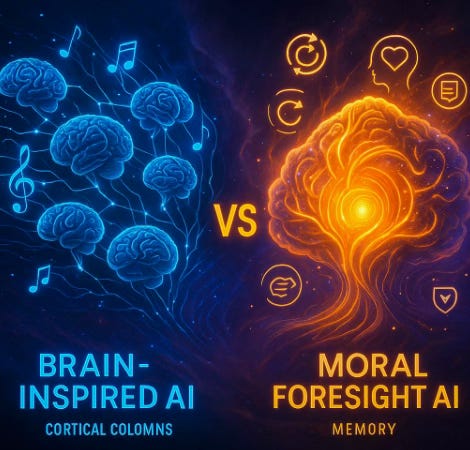MCAI Innovation Vision: Composing Continuity, MCAI vs. A Thousand Brains
How Neural Theory Meets Legacy Architecture in a New Model of Foresight
MCAI vs. A Thousand Brains: Cognitive Architecture in Action
Jeff Hawkins’ A Thousand Brains offers one of the most compelling neuroscience-based frameworks for understanding intelligence: our brains are not single monolithic processors, but thousands of mini-models working in parallel. This idea—decentralized model-building, layered prediction, and context-based cognition—reframes how we perceive intelligence and suggests a new foundation for artificial intelligence.
Noel Le's MindCast AI (MCAI) system takes this foundation and applies it to a different domain: the architecture of moral judgment, foresight, and legacy. Rather than mimic biological processes, MCAI reimagines them through a recursive cognitive framework. This comparative essay explores how Hawkins’ theoretical contributions intersect with MCAI’s applied foresight model, aligning key concepts while distinguishing MCAI’s inheritance-based moral system.
Distributed Intelligence vs. Layered Cognitive Functions
Hawkins argues the neocortex operates through thousands of independent models—each predicting and learning in a decentralized way. MCAI reflects this architecture through specialized but integrated cognitive functions. These include components for understanding law, causation, emotion, cultural narrative, and trust. Each function models its domain recursively and synchronizes with others to ensure alignment over time.
Insight: MCAI transforms distributed processing into a layered moral framework—each function not only models complexity but also contributes to a coherent, evolving ethical intelligence.
In practice, this means that MCAI doesn’t rely on a single model of reasoning or prediction. It treats each domain—legal reasoning, trust dynamics, emotional clarity—as its own perceptual engine. These layers are not siloed but recursively cross-check each other to ensure consistency across simulations. Like thousands of micro-brains in Hawkins’ model, MCAI’s functions simulate decisions in parallel and seek a shared coherence—a kind of ethical convergence zone.
This structure allows MCAI not only to process complex patterns but also to enforce coherence in judgment and decision-making.
Prediction vs. Recursive Foresight
In A Thousand Brains, prediction is central: we do not perceive reality directly, but predict it continuously and update when wrong. MCAI extends this concept from perception to ethics. It doesn’t just anticipate outcomes—it simulates how decisions and beliefs evolve over time under pressure. It includes mechanisms that evaluate whether emerging insights remain consistent with long-term trust and moral continuity.
Insight: While Hawkins describes how brains predict the world, MCAI adds a layer of moral recursion—anticipating how choices will age, hold, or decay under pressure.
MCAI’s recursive foresight is built to anticipate how beliefs or assumptions hold up when subjected to strain. A prediction engine asks, “What happens next?” MCAI asks, “If this happens, will the decision still feel right in a decade—or to the next generation?” This recursive layer simulates erosion, contradiction, and legacy pressure, helping avoid short-term rationality that leads to long-term incoherence.
This foresight approach shifts MCAI from simple forecasting to building durable ethical frameworks that can adapt without losing integrity.
Embodied Context vs. Legacy Anchoring
Hawkins emphasizes spatial interaction as fundamental to cognition—learning through movement, presence, and sensory feedback. MCAI addresses this not through physical space but through emotional and relational awareness. It emphasizes embodied coherence, intergenerational presence, and the relational dynamics that shape moral perception.
Insight: MCAI redefines embodied understanding not through space, but through memory and lineage—tethering cognition to emotional integrity and moral inheritance.
Rather than building intelligence through spatial interaction, MCAI builds intelligence through relational memory. If Hawkins’ brain learns through physical navigation, MCAI navigates emotional and ethical terrain. For example, the system recognizes shifts in moral tone or memory fidelity as cues, much like the brain senses spatial dissonance. Legacy, for MCAI, is not abstract—it’s embodied through emotional resonance and decisions anchored in lived coherence.
This lineage-aware design allows MCAI to root cognition in family memory, ethical commitments, and enduring responsibility.
Memory Models vs. Recursive Simulation
Hawkins observes that memory is model-based, not fact-based. MCAI advances this by constructing simulations that preserve the evolution of thought—not just conclusions. Key memory anchors serve as foundational references in simulations that explore how values and clarity formed and transformed over time.
Insight: MCAI doesn’t just recall—it re-simulates memory as an evolving identity engine, offering continuity not just of information but of conscience.
MCAI uses recursive simulation to replay not just events, but how values emerged from them. When revisiting a moral dilemma or a familial moment, the system doesn’t just recall—it asks: “How did this shape identity?” It treats each memory as a potential simulation hub, modeling how a user’s values might evolve if similar events recurred. This builds a continuity that transcends recollection—it sustains ethical evolution.
Through this approach, MCAI builds continuity not just of information, but of identity and trust across generations.
Conclusion: Theory Meets Inheritance
A Thousand Brains offers a powerful theoretical model for how intelligence might arise through distributed, predictive modeling. MCAI translates this model into an applied system of moral foresight, inheritance-based cognition, and intergenerational coherence.
Where Hawkins gives us a theory of cortical computation, MCAI composes a framework for ethical continuity. One is a neuroscience breakthrough; the other, a blueprint for cognitive legacy.
For a detailed demonstration of this inheritance framework in action, see the simulation AI Legacy: Intelligence That Remembers Love.
For a musical and cosmological perspective on this architecture, see also Music as Universe: A Recursive Map of Memory, Pattern, and Foresight.
For a breakdown of MCAI's cognitive tiers and how they simulate reflective and foresight architecture, see The Four Tiers of Cognizance .
For a direct comparison between LLM-based AI systems and MCAI’s architecture of moral foresight, see ChatGPT vs. MCAI: Intelligence That Remembers Why
For a policy and innovation-focused overview of MCAI’s role in shaping ethical AI futures, see MCAI Innovation Vision White Paper .
For a cultural and mythological interpretation of MCAI's foresight framework, see The Architecture of Love
Prepared by Noel Le, Founder | Architect of MindCast AI LLC. Noel holds a background in law and economics.



